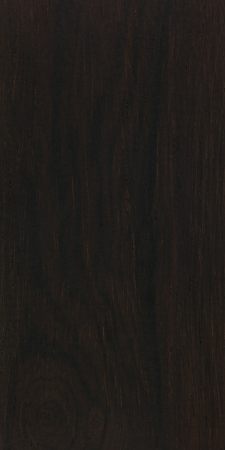
Common Name(s): Brazilian rosewood
Scientific Name: Dalbergia nigra
Distribution: Brazil
Tree Size: 100-130 ft (30-40 m) tall,
3-4 ft (1-1.2 m) trunk diameter
Average Dried Weight: 52 lbs/ft3 (835 kg/m3)
Specific Gravity (Basic, 12% MC): .68, .84
Janka Hardness: 2,790 lbf (12,410 N)
Modulus of Rupture: 19,570 lbf/in2 (135.0 MPa)
Elastic Modulus: 2,020,000 lbf/in2 (13.93 GPa)
Crushing Strength: 9,740 lbf/in2 (67.2 MPa)
Shrinkage: Radial: 2.9%, Tangential: 4.6%,
Volumetric: 8.5%, T/R Ratio: 1.6
Color/Appearance: Brazilian rosewood can vary in color from a darker chocolate brown to a lighter purplish or reddish brown, with darker contrasting streaks. The black streaks can sometimes form a unique grain pattern that is sometimes referred to as “spider-webbing” or “landscape,” very similar to ziricote. Lighter yellowish sapwood is clearly demarcated from the heartwood.
Grain/Texture: Brazilian rosewood has a uniform, medium to coarse texture with medium-sized open pores. The grain tends to be straight, but can occasionally be interlocked, spiraled, or wavy.
Rot Resistance: Heartwood is rated as very durable to decay resistance, and is also resistant to insect attack.
Workability: Easy to work with both hand and machine tools, though it may have a slight blunting effect on cutting edges. Brazilian rosewood turns, and finishes well, though it can sometimes be difficult to glue due to its high natural oil content.
Odor: Has a distinct, rose-like scent when being worked.
Allergies/Toxicity: Although severe reactions are quite uncommon, Brazilian rosewood has been reported as a sensitizer. Usually most common reactions simply include eye and skin irritation. See the articles Wood Allergies and Toxicity and Wood Dust Safety for more information.
Pricing/Availability: Likely to be very expensive, and from questionable sources. Trade of Brazilian rosewood is highly regulated, and sales are generally limited to reclaimed or pre-existing pieces of lumber.
Sustainability: Brazilian rosewood is listed in CITES Appendix I, which is the most restrictive appendix, and also includes finished products made of the wood. It is the only species whose listing supersedes the already restrictive genus-wide restriction on all Dalbergia species listed in appendix II. It is also listed on the IUCN Red List as vulnerable due to a population reduction of over 20% in the past three generations, caused by a decline in its natural range, and exploitation.
Common Uses: Veneer, fine furniture, cabinetry, flooring, musical instruments (acoustic guitars, piano cases, etc.), turned objects, and other small wooden specialty items.
Comments: Brazilian rosewood, like other exploited hardwoods such as Cuban mahogany or teak, has earned worldwide fame. Historically, it has perhaps been the species most frequently associated with the term “rosewood,” and with its strength, hardness, stability, beauty, and acoustic properties, it’s easy to see why Dalbergia nigra has been used for everything from flooring to xylophone keys.
Due to the high demand and limited supply of Brazilian rosewood, and its continued exploitation in recent decades, it has been listed in the most restrictive category of endangered species: CITES Appendix I. Not only is the lumber restricted from being imported or exported from country to country, but even finished products made of Brazilian rosewood may not cross international boundaries.
Because of these heavy (yet justifiable) restrictions, several substitutes from the Dalbergia genus have been used in recent years, such as East Indian rosewood, Honduran rosewood, and cocobolo; though perhaps the closest rosewood in terms of color and appearance may be Amazon rosewood (Dalbergia spruceana)—another hard-to-find and pricey rosewood.
Images: Drag the slider up/down to toggle between raw and finished wood. (You will note that the color over time tends to become very dark, almost black. This is partially due to the old age of most pieces, often collected before the 1992 CITES restriction.)


Watch video of wood finish being applied.
Identification: See the article on Hardwood Anatomy for definitions of endgrain features.
Porosity: diffuse porous
Arrangement: solitary and radial multiples
Vessels: medium to very large, very few; dark brown deposits occasionally present
Parenchyma: diffuse-in-aggregates, vasicentric, sometimes weakly aliform and/or unilateral, and banded (marginal)
Rays: narrow, normal spacing
Lookalikes/Substitutes: Most commonly confused with East Indian rosewood, the two can usually be separated on the basis of pore density: Brazilian rosewood has roughly half as many pores per square surface area (see related article for more info).
Notes: Unlike most Dalbergia species, D. nigra‘s heartwood extractives are not water-soluble, and a water extractives fluorescence test will produce no fluorescent response.
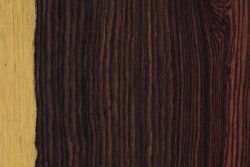
(Dalbergia congestiflora)
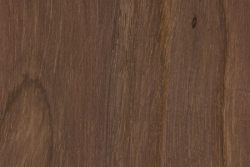
(Dalbergia cubilquitzensis)
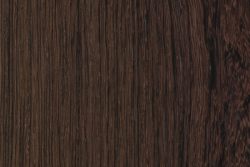
(Dalbergia lanceolaria)
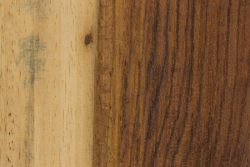
(Dalbergia odorifera)
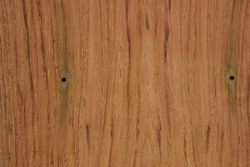
(Dalbergia paloescrito)
Related Content:

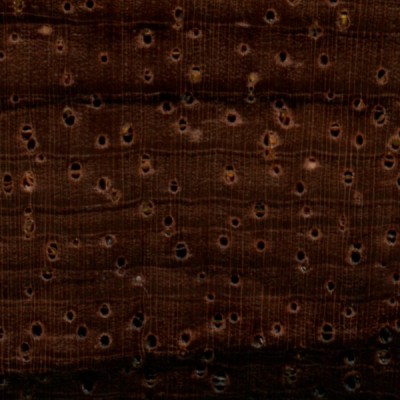
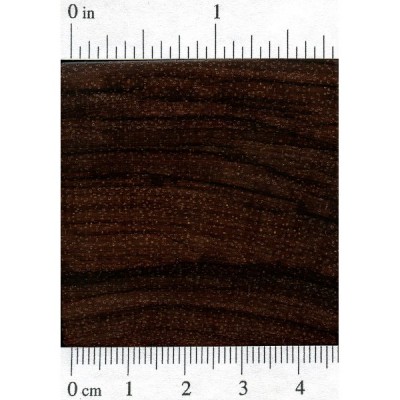
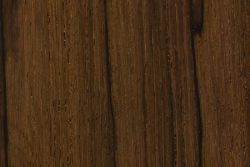
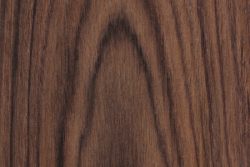
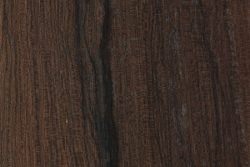
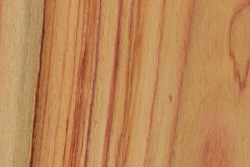
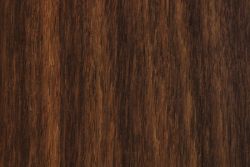
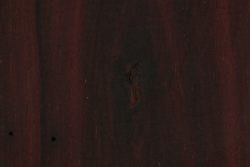
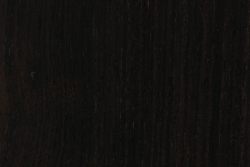
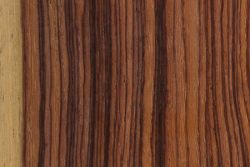
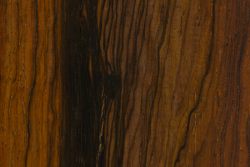
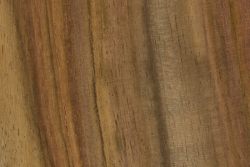
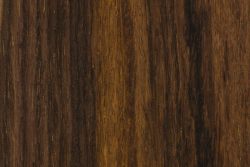
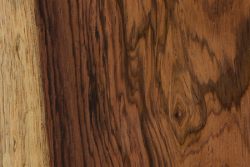
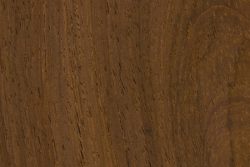

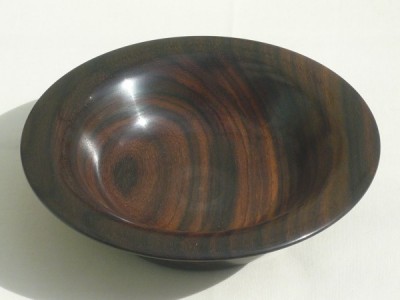
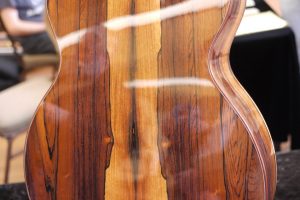
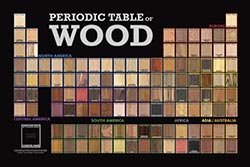

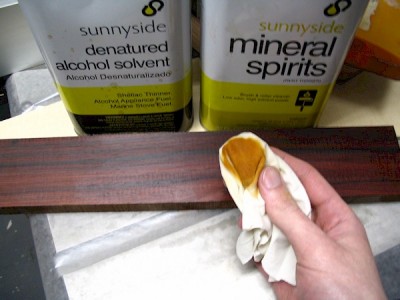
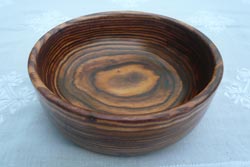



I just wanna add a general comment instead of replying to everyone with a photo attached. If you have a piece of rosewood (doesn’t matter the sub species) or is looking at a piece claimed to be rosewood, but looks more like mahogany or even teak, know that as long as it has the characteristic black lines in its veins, then it is most likely authentic rosewood. Rosewoods have a tendency to fade when exposed to UV-radiation years on end. I restore retro furniture for a living and have restored quite a few rosewood pieces that were severely bleached by… Read more »
Hello.What is the type of tree I share in the image?
Here are a few other pictures.
Hi, could you please.tell me if this Brazilian Rosewood flat sawn and would this be considered a desirable guitar back opposed to one that is straight grained quarter sawn? Thank you in advance!
Few nice pieces, very curly, probably stump wood. Nevertheless, beautiful
I’m curious now if this is actually Brazilian rosewood. I was told it was mahogany.
Looks more like mahogany me. Would need closeup pic of end grain to tell for sure, though.
I restore retro furniture for a living and a lot of retro furniture is made with rosewood, so I’m 90% sure it’s a Dalbergia, although I don’t think it’s Brazilian (D. Nigra), considering the clearly contrasting black veins among the more reddish ones. Rosewood has a tendency to fade when exposed to sunlight for several years. At my work we fix this using a mix of waterbased powder stains, before resealing with lacquer. Curiously enough, one of those are mahogany brown, although that color is more bright red than brown – the other stain is antique oak, we do a… Read more »
I restore retro furniture for a living and a lot of retro furniture was made with Dalbergia spp. veneers. I have yet to see a mahogany subvariant that has black streaks in its veins. Dalbergia spp. have a tendency to lose their reddish colors and turn more yellow and faded when exposed to sunlight for years on end. It can usually be fixed by using staining to recreate the original look and then reseal it, but it cannot be prevented by any other means than shadow.
I have an almost identical finger board, I know for a fact it’s Brazilian RW.
Your piece I would happily buy, once it’s finished on the neck it’ll look even better I’m sure.
Hello, I enclosed some photos of old french bassoon (ca.1880) from Dalbergia nigra. Some fragments are still covered with varnish and have retained a lighter color, other fragments of wood from which the varnish has worn off are completely black. I took the photos in strong sunlight to show the structure. In the room, the wood is black and purple.
Hello! Would you say this is brazilian rosewood? Thanks!
Hello. Attached are a couple photos I would like you to take a look at if you can. One photo shows a smaller piece of Brazilian Rosewood I acquired back in the early 70″s when I worked as a cabinet maker. The larger piece (in question) I recently acquired at a garage sale. Although it looks like BR and smells like BR, I just wanted your opinion. The second photo shows the end grain of the large piece in question. Not the best photo, but after alot of sanding, and photo tries, the best I could do.Thanks for any help.… Read more »
While I can’t say for sure, I would say that Brazilian rosewood is a definitely possibility. I see nothing that would cast doubt or disqualify it from being a candidate. The only thing is that the wood is very dark (which would be expected for this species and possible age of the piece), so it’s very hard to see all the details in the endgrain. I can’t quite make out much parenchyma from the endgrain photo, but everything else that I can see seems to line up.
I would need to see a clear, closeup photo of the endgrain to get a better idea of likelihood of Dalbergia nigra.
I would say that it does overall look like a rosewood species, and the fact that it has so few pores would also be a vote in favor of Brazilian rosewood. While I can’t say for 100% sure that that’s what you’ve got from the pictures, I would also say that I see no reason to doubt the ID based on the pictures you provided.
Can anyone identify this wood? It looks like rosewood, but I figure it cannot be, because is bought 4 chairs made out of it, and I thought it was no longer imported.
Please attach pics.
Brazilian rosewood, Dalbergia nigra has to be one of the most beautiful woods on this earth. Older furniture was sometimes made from it, but mostly used as veneer, such was the high value placed on it. Sadly it is virtually cut out now and only available in antiques if you want to cannibalize these for the wood. I like to make guitars with this outsatanding wood because of it’s aesthetic qualities and sonic properties.
That guitar has either seen a lot of sunlight or is another rosewood species than Brazilian. It’s fixable with staining though (after removing the finish of course). A roughly 50/50 mix of waterbased stains (mahogany brown and antique oak), test on an invisible or near invisible spot (too much red can be fixed with more antique oak in a thin mixture later), then sand with 120 grit (anything higher will block the pores in the wood) and seal with new lacquer. I restore retro furniture for a living and quite a few are either rosewoods or veneered with rosewood (or… Read more »
Hi Eric,
I was wondering if this mid-century table is rosewood. The seller was unsure and don’t know if you can tell by the grain pattern alone?
Thanks for your help!
Hello
I bought this wood called Brazilian rosewood. I want to know that Brazilian rosewood lt is
The seller said he was over 70 years old
thanks
1977 home- myself and my husband have a wood entry center wall. 10ft to 17ft- that spans the back of a frame center room. It has beams also. I was told the people had a interior designer when they built the home and many items are hand crafted. I look at the wood and wonder What it is, and now I am thinking maybe rosewood of some kind. Can you take a look please.
That looks like Oak to me.
Yes that’s oak, it is very nice oak though and you don’t usually see that much figuring in wall wood though. The strips of wood may very well be Brazilian rosewood though.
Hi Eric,
I wanted to know if pocket knife manufactures that still use Brazilian Rosewood for there handles use
“new” cut Brazilian Rosewood or reclaimed or pre-existing pieces of lumber? Thanks
Hi
Wonder if this is a pies of Dalbergia Nigra, I have an old stock of veneer that if the old documents is right, so it is ca 180m2 Brazilian Rosewood and 2 plank 30 x 200mm x 3900mm of the same i think.
Hälsn Harry
Sweden
It certainly looks like it could be the genuine article. Pore size and density look about right; does have a strong floral smell when being worked? Interesting to also note the dark oxidation that appears to have crept perhaps 1/8″ into the surface of the board — you can also see how dark the old sample that I have pictured as the representative of this species is as well.
It smells EXACTLY like that old baseball card gum we used to get..when sanded…and also just on the face. I knew it was brw when the guy opened the shed..i smelled it before seing it..i said ill take it before seeing it. 7’2″ 12″ wide 5/4. For the pricely sum of $100. About 3/4 of the piece is useable and there are some deep gum, check split…which is very common for this species. I have a few pieces of this stuff and a little pile of 10×8 veneer squares…the big piece, pictured, i had to cut in hslf to grt… Read more »
This is Brazilian Rosewood, dalbergia nigra….half is sanded the other half is 58 yrs oxidized. Beside it is dalbergia decipularis..tulipwood.
Hi Eric,
An online ad for this side table states it’s made of teak but if so, the grain patterns seem unusual to me. Since it’s a mid century piece (Danish style), I’m wondering if it might perhaps be rosewood? I love following your website replies! Thanks,
Tom
Very hard to tell from the picture, but I think I can make out in the lower center portion an area near the growth ring that appears to show the pores arranged along the growth boundary (ring porous), which would corroborate with the teak ID. (Most rosewoods are diffuse porous.) The color is also not outside the realm of possibility for teak.
Hi Tom,
That’s teak, very nice teak as well. Teak isn’t less than Rosewood, its just different and what you have there is really nice.
Jeff
My neighbor cut his tree down and so I asked if he knew what kind of tree it was. He said it was jacaranda. I had never heard of it so I looked it up here and it said that it was Brazilian rosewood. It looked light compared to the Brazilian rosewood I’ve seen (mostly on hand planes). Is this jacaranda and is jacaranda also known as Brazilian rosewood?
The name Jacaranda is used a lot to describe a host of different woods. More than likely, you’ve got something like this: https://en.wikipedia.org/wiki/Jacaranda_mimosifolia
Hello.
I have a snooker cue in ash, ebony and another wood I can’t identify. Watching your webpage I suspect it can be some kind of rosewood. I send you one picture. I could send you more pictures, if required.
I’m very glad of my cue and, if it is in rosewood or even cocobolo I will be more glad, if possible.
Apologies for my bad english. I’m Spanish.
Thanks a lot for you stay there.
It does look like some type of Dalbergia (rosewood) species. Is it possible to get a clear, closeup picture of the endgrain? It can be tough to ID finished pieces, but seeing the end might help.
Hello, Eric. Thanks a lot for your answer.
I send you a picture. The cue’s butt end (where the endgrain is visible) is often very damaged by the use. At this moment, I have not a superfine sandpaper to fix it. I hope the picture be not too bad.
If you want, I could send an infinite number of pictures. Have I said I’m very glad of my cue…?
Thanks a lot to be there.
Hmm, well I don’t want to steer you wrong, and it’s hard to tell from just one endgrain photo, but that endgrain is somewhat unusual, at least for Brazilian rosewood. I can see pretty extensive and uniform parenchyma bands, which isn’t too common for Dalbergia nigra. It could be some other type of rosewood from Asia or Africa (such as Madagascar rosewood), but I will say that the parenchyma bands look very uniformly spaced, which is unusual for rosewoods and, at least to me, points more to Swartzia species such as Katalox or Wamara.
hi eric, i am repairing a 60 year old Portuguese trestle table ,30 inches wide x 79 inches long . i’m trying to i.d. the wood used in the manufacturing. these are snaps of one of the leg frames ,it’s not a heavy wood,sands easily .thickness is 2 1/4 inches. the table was left out in the elements for a couple years. that means a huge amount of moisture exposure here in vancouver b.c. could you give me any ideas?
not sure if all photo’s will show up can send them via email
It looks like a type of ring porous hardwood, but I simply can’t tell from the picture, can you get some closer pics? Also, a good shot of the endgrain would be helpful if possible. The most likely candidate at this point would probably be oak.
Greetings!
I came across some lumber that was supposedly used for ship ballast. It is apparently quite old, though I have no idea when ships used exotic hardwood for ballast. I have been told this lumber could be at least 70-80 years old. I have several pieces I was hoping someone here could help me to identify.
It was suggested to me that it may be some type of rosewood, but I just can’t tell based on photos I have seen online. Anyone have any idea?
I’d say, just from an initial impression, that it is HIGHLY unlikely to be Brazilian Rosewood. Need to see a clear, closeup, finely sanded picture of the endgrain to get a better idea on ID.
Thanks again Eric. I will try to cut the endgrain and post up a photo later.
Here i the end grain, not as finely sanded sorry. Next post a ribbed a little oil to see it better.
It’s hard to get a sense of the scale of it, but I will say that initially it looks like the pores are way too numerous to be Brazilian rosewood. They are very infrequent and less densely packed in Dalbergia nigra.
Oiled
I have some pedra that looks exactly like that, unfortunately there’s not a lot of good pictures in this database, it if you google it, that might help
I have a little old growth lumber left over from a bank job. My Father and I were custom millwork manufacturers and one of the jobs we did in the late 60s was entirely Brazilian Rosewood. We had a log flown over and Diamond Hill Plywood in Darlington, SC laid the veneers for us, book matched, sequenced matched with integral door panels and all solid trim Brazilian Rosewood. Back in the 60’s, even then, the wood was hard to come by. Board lengths were hardly over 6 or 7 feet long. I wonder what the board foot price is today?… Read more »
A guitar maker (Frankie Montuoro) claims to be using a wood very similar
do Brazilian Rosewood called “Conscia Silva”. I live in Brazil and
never heard about any wood with that name. Does anyone here knows what
wood is that? Here’s the article where the Luthier talks about that
wood: https://www.fretboardjournal.com/columns/bench-press-frankie-montuoros-bench-copies/
I have no idea; this is one of the pitfalls of using common names instead of including a latin name, as they very frequently can get confused and provide no help in finding the exact wood species. I will say that the statement “belongs to the same plant genus as Dalbergia nigra with respect to being in the Legume and Fabaceae family” is very misleading. I am guessing he just got his terminology wrong when he said “genus” because later he clarifies that it is actually the “family” (Fabaceae) that he was talking about. This plant family includes hundreds of… Read more »
I have a wood plank of approximately 40 years old (38 X 16 X 1,5 inches), that looks very similar to Brazilian Rosewood. It was part of my grandfather’s woodworking workbench. Anybody see any similarities with Brazilian Rosewood? By the way, i live in Brazil. Here’s some photos (the photo with the scale is in 0,5mmm and the diferences in color are because of the camera flash) :





More than likely not Brazilian Rosewood. From the endgrain, the pores appear to be too small and too numerous.
If you’ve sanded it or worked with it, have you noticed any distinct scent? I don’t know if you’ve smelled rosewood before, but it’s a memorable scent.
The wood dust from the plank have a very pleasant scent, but i never smelled rosewood before.
Brazilian rose has an almosy chocolate like sweetness to it.
A professor from a Brazilian University (ESALQ) identified it as Imbuia.
Makes perfect sense. Imbuia also has a distinct scent.
I have been offered a pipe made from this (supposedly) Being as the wood has a high oil content Does anyone think that smoking it may not be healthy?
Unfortunately these trees are quite tender when young , they need to be grown in places of high humidity , and shelter from direct light, the forest floor is a dark and moist and a constant 23 degrees centigrade . In other words , if you want this tree you have to supply the forest .
C’mon man!, even if there is some kind of shortage, just plant more trees! It’s not like it’s gold or silver – it is a renewable resource for crying out loud, you plant the seedling and it grows into big tree, chop down tree, make guitars, plant more! Repeat.
Not exactly. It’s more like: plant more trees, and your GRANDKIDS will chop them down. Not exactly a practical solution, especially since there are other tree species that can be harvested much sooner, and will be more financially profitable.
Right. Plant more trees. That sounds simple enough. How many have you planted by the way? But until disadvantaged people in developing countries are no longer exploited, threatened, even murdered for the wood you want for your guitars, maybe you could do the planet a favor, and consider sustainable alternatives for crying out loud.
AMAZING! Thanks for setting the stupid ones straight. These trees are also very environmentally specific. Their natural habitat is being destroyed by city growth. Its almost impossible to effectively bring back the population of these trees within the foreseeable future. However I would like to think that some day they’ll be back to their full strength and everyone can responsibly enjoy this beautiful wood.
City growth. Is that the sanitized euphemism for rain forest destruction these days? But, I wouldn’t say stupid; I’d say self-involved, reckless, irresponsible, even naive, but not stupid. You’re correct about their environmental specificity, and that can be said for many of if not most of the endangered species of flora & fauna. I also agree that bringing these trees back to sustainable populations will be difficult, and maybe impossible. Their endangerment is partially caused by complex economics of impoverished nations who need every bit of export money they can get; any government can put a stop to the export… Read more »
i don’t think that the deforestation is due to city growth. And the main culprits in culling D nigra were the Japanes, who used helicopters to deforsetremote, hard to access locations.
Yeah do not think you understand, how long it takes for a tree to reach maturity. Even if it’s a fast growing tree, which Brazilian rosewood is not. The time to plant a Brazilian rosewood tree, was 20 years ago. And still would not have the quality of a Brazilian rosewood tree that was say 500 or more years old. As at 20 years it would be inferior to an older tree.
johnny guitar doesn’t know where they grow……
Dalbergia nigra needs a habitat of wet and damp (hygrophilous) forest on rich soils to thrive. It is only found in the Atlantic Forest of southeastern Brazil, from southern Bahia to Minas Gerais and Rio de Janeiro.
It struggles anywhere else.
… Dalbergia Nigra, also known as a Jacaranda, is prevalent all over Southern California, they are purple flowering trees that you would not want to park your car under. They are also growing in Japan. There is no difference between Brazilian and non Brazilian wood, which is a HUGE issue for luthiers. Back in the 1970s, Martin made about 50 guitars using Jacaranda, and those who owned Brazilian Rosewood Martins screamed so loud, they never made another. Yamaha is the only large guitar maker that currently builds using Jacaranda (they have never built a Brazilian Rosewood Guitar), and they are… Read more »
You are confusing the flowering jacaranda (Jacaranda genus) with Brazilian rosewood (Dalbergia genus). They are unrelated. The wood from the flowering jacaranda has little value. The name ‘jacaranda’ is used to denote various figured rosewoods. It is not specific.
that looks like dalbergia nigra. And it is definitely veneer. I recently saw a piece I made in 1981 & the colour had lightened, similar to your picture
Can anyone tell me if this is rosewood, and if so, what kind??
No one seems to be able to tell me!
Bud,
I think they may have been referring to the allergic properties of the wood coming into contact with your mouth. It’s all relative I suppose, depending on the amount of risk you’re willing to take with contacting the wood on a regular basis. It’s a very similar concern to that of using rosewood for mouthpieces to woodwind instruments.
As a pipe smoker, I have seen several pipes made of rosewood listed on ebay. On a pipe-smokers list, a woodworker said that rosewood pipes should never be smoked, due to irritant and allergic qualities. The type of rosewood these pipes are made of is never specified in the offerings; but at least two oldish pipe books sing the praises of rosewood pipes, calling the smoking effect “hypnotic” and “soporific.” One of the books specifies the Brazilian rosetree, or “palissandre” in French. Is this hazardous to smoke? Should “rosewood” pipes be avoided?
Cocobolo is well known for its beautiful coloration. Even though i’ve only worked with cocobolo twice.
You may try to smell it, most rosewoods have they’re own distinct smell.
Looks like Cocobolo to me, at least in terms of the color and pattern. Is it real wood, and is it solid? Might want to check out: https://www.wood-database.com/wood-articles/wood-identification-guide/
Can anyone tell me if this is rosewood, and if so, what kind??
No one seems to be able to tell me!